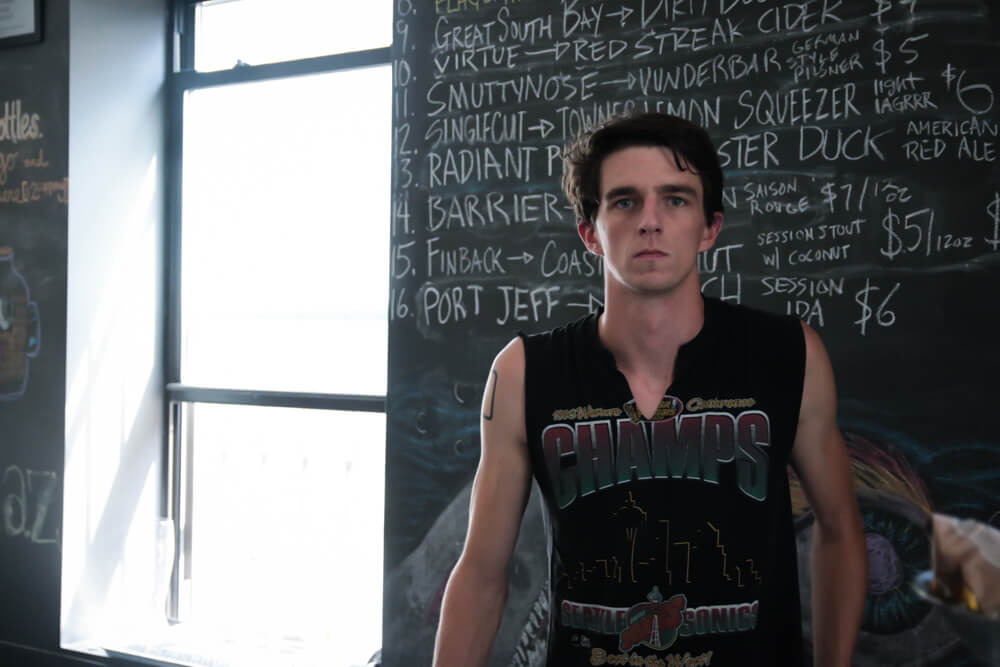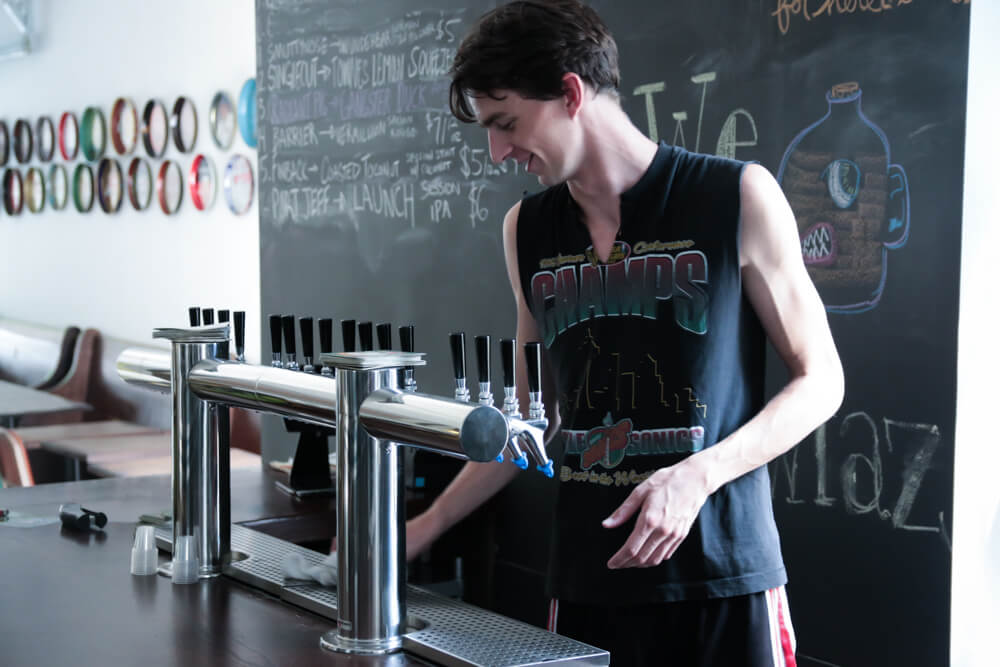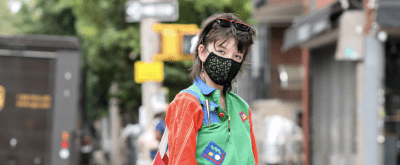Tricks of the Trade: Tap List 101 with Covenhoven Cellar Manager James Case

James Case, VERY SERIOUS.
Since its March, 2014 opening, James Case has become Covenhoven’s number one golden child. Tall — very, very tall — and undeniably charming with a wide, boyish grin, James fell into the beer scene soon after moving to New York City from his native Seattle. After a career-shaping stint at Bierkraft, Park Slope’s inimitable craft mecca, James was tapped by Covenhoven’s Bill Pace and Molly Bradford Pace to personally build and guide their impressive beverage program. With James’ help, the friendly, neighborhood bottle shop hit the ground running, lining up a packed schedule of choice events and consistently showcasing one of the best tap lists in the city.
This week, the big man himself was kind enough to give me the inside scoop on what goes into curating a truly standout draft list.
MH: How did you get into beer?
JC: I met [former Bierkraft cellar manager] Joe Tracy when I was in college at Evergreen. He taught me how to brew and started taking me around to beer bars and bottle shops. I remember the first time I had a Nitro IPA back in Olympia and being so very confused and so very excited.
MH: What was your first paying job in the industry?
JC: I worked at Bierkraft in Park Slope when I first got to the city. A few hours after I got off the plane, I met Ben Granger at a party at Brooklyn Brewery and he offered me a job.
MH: What’s your job title at Covenhoven and what do you do on an average day?
JC: My job title is Cellar Manager, but what that really means is that I’m responsible for buying the beer and managing the bar. An average day involves me emailing reps, reading BeerPulse for news, parsing RateBeer for reviews, checking inventory, communicating with the staff, throwing kegs around the walk in, coordinating draft rotation, and of course, buying some beer.
MH: What’s your idea of a perfect tap list?
JC: Balance is key. I like a little bit of everything: one or two hoppy lines, something dark, something light, something strong, something sour or funky and at least one beer that makes you say, “I’ve really wanted to try that!” — or maybe, “What the hell even is that?” Also, it’s good to run something cheap and recognizable for the sake of comfort.
MH: Tell me about what’s on tap at Covenhoven right now.
JC: Right now, we have a few Sixpoint kegs left over from an awesome event last Friday — I worked closely with our Sixpoint rep to line up a good array of big, dark brews for that. To balance it out, there’s some lighter stuff from Barrier, Grimm, Threes and Ballast Point. We’ve got hoppy stuff from Other Half because buying local is the best way to make sure it’s the freshest, especially when you personally know they kegged it that very morning. Sam and Matt are just killing it right now. Then there’s more hops from Evil Twin, because Molotov Lite is ridiculously good, and a Midnight Sun keg because their draft beer is hard to get in New York and should definitely be jumped on given the chance.


James Case, considerably less serious.
MH: How did you curate that list and what factors went into your decisions?
JC: Price points are definitely important part of the decision making, but what can be more important is the size of the keg. It may be beneficial to grab a half keg you know will sell steadily for a better price, but conversely, it can be an even bigger benefit to take a bit of a price hit on a smaller keg of heavy, sour or esoteric beer that you don’t want to have lying around too long, giving customers the idea that it’s no good.
Maintaining good relationships with reps is also super important because: A) they might let you know when something special comes in before other people know; B) they will let you know if something happens to be discounted in any way, which is a rare, eclipse-like situation that should be jumped on immediately (it’s an industry no-no to ask for a price break); and C) most beer reps are generally awesome people that you like having in your bar to begin with, because they know beer well and, in order to even get their job, they have to be genuinely interesting people.
What goes through my head most is trying to maintain a fair balance between the major distributors, while giving love the local self-distributing guys. Sometimes I’ll have to parcel out which distributor gets ordered from each week depending on which beers I from them, or I’ll be waiting to order a certain product — the timing of orders has to be perfect. And if you have a tight budget, this process becomes much trickier. Having worked as a rep myself for a short minute, I remember how quickly I turned numb if a buyer said, “In the next week or two,” trying to put off committing to an order. So when a buyer actually follows up with a rep in the promised amount of time, the rep knows the buyer serious about what they’re saying, and it wasn’t just a crock of shit to get the rep of the buyer’s back. All that builds trust between the buyer and the rep, which is good for the tap list and good for the bar.
On the flipside, the best reps will know if I genuinely forgot an order because I probably also have a personal relationship with them, so they won’t take a business flub to heart. My favorite reps — we usually don’t talk about beer at all, actually. Well, except for Phil Beglin. We only talk about beer, videogames and Super Wings. He’s my favorite, but it’s a tie with Joe Harer from Other Half. We only talk about The Simpsons.
MH: What beers or beer styles tend to sell best at a neighborhood beer bar like Covenhoven?
JC: Sours and hoppier stuff seem to be the best selling on a consistent basis. And local stuff will sell better than far away stuff, even if the local is more expensive.
MH: What other Brooklyn bars would you recommend as having great tap lists?
JC: Torst has a fantastic taplist, obviously — Mike picks cool stuff. Steven at The Owl Farm does a great job curating lines, setting up good events and locking down hard-to-find kegs. The same goes for Crimson over at Mission Dolores and whoever the buyer is at Bar Great Harry. Sam at Bierkraft gets great kegs and with their system, they move through it quickly — that’s a huge boost to their program. And Chris at Double Windsor always keeps a great list.
MH: What do you think is The Most Important Factor to consider if you want to build a killer tap list?
JC: Being able to rotate your selection on a regular basis is definitely a big thing. But what really factors in the most is just being a cool person and cultivating relationships with everyone you meet. Even if you have the greatest palate and the highest level of beer knowledge, you might miss out on a rare keg if you’ve pissed somebody off.
You might also like 



















